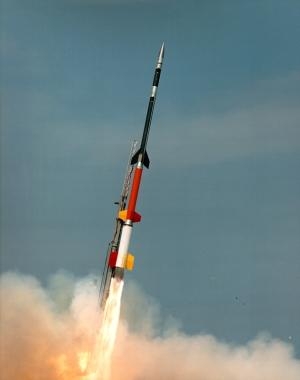Tue, May 28, 2013
CIBER Sensor To Be Launched On A Suborbital Sounding Rocket June 3
When did the first stars and galaxies form in the universe? How brightly did they burn their nuclear fuel? Scientists will seek to gain answers to these questions with the launch of the Cosmic Infrared Background ExpeRIment (CIBER) on a Black Brant XII suborbital sounding rocket between 2300 and 2359 EDT, June 4 from the Wallops Flight Facility in Virginia.

Jamie Bock, CIBER principal investigator from the California Institute of Technology, said, “The first massive stars to form in the universe produced copious ultraviolet light that ionized gas from neutral hydrogen. CIBER observes in the near infrared, as the expansion of the universe stretched the original short ultraviolet wavelengths to long near-infrared wavelengths today. CIBER investigates two telltale signatures of first star formation -- the total brightness of the sky after subtracting all foregrounds, and a distinctive pattern of spatial variations.”
“The objectives of the experiment are of fundamental importance for astrophysics, to probe the process of first galaxy formation, but the measurement is also extremely difficult technically,” he noted.
This will be the fourth flight for CIBER on a NASA sounding rocket. The previous launches were in 2009, 2010, and 2012 from the White Sands Missile Range, New Mexico. After each flight the experiment or payload was recovered for post-calibrations and re-flight. For this flight CIBER will fly on a larger and more powerful rocket than before. This will loft CIBER to a higher altitude than those previously obtained, thus providing longer observation time for the instruments. The experiment, which will safely splash down in the Atlantic Ocean more than 400 miles off the Virginia coast, will not be recovered.
CIBER previously flew on two-stage Black Brant IX sounding rockets. Bock said, “The collection of data from the three flights allows us to compare data and rigorously test sources of potential systematic error from both the instrument and astrophysical foregrounds. We have been through the end-to-end process in analyzing our data, so we understand the benefits of going with a non-recovered Black Brant XII. We also know the performance of the instrument very well from these flights and that makes us confident going forward with this more capable but final flight.”
The 70-foot tall four-stage Black Brant XII rocket will carry CIBER to an altitude of about 350 miles. According to Bock, “This flight is pioneering a new direction in the astrophysics program in that we are flying our instrument on a non-recovered Black Brant XII. The XII gives us a significantly higher trajectory, providing about 560 seconds of flight time above 250 km (155 miles) altitude, compared with 250 seconds on standard Black Brant IX flights out of White Sands.”
“Our experience in the near-infrared waveband is that we see appreciable emission from the atmosphere up to 250 km. The higher trajectory allows us to do some new things that are not possible on a Black Brant IX. For example, we expect to have enough independent images of the sky to directly determine the in-flight gain of the infrared cameras, which will allow us to measure background fluctuations in single exposures. This gives us a much more direct way to compare with satellite data than the statistical combinations we have had to use to date. The higher trajectory of course comes with a price in that the payload is not recovered,” he said.
CIBER is a cooperative instrument designed and built by the California Institute of Technology, University of California Irvine, the Japan Aerospace Exploration Agency (JAXA), and the Korean Astronomy and Space Science Institute (KASI). The same team is also developing an improved follow-on experiment, with more capable optics and detector arrays, that will be completed next year.
Backup launch days for this project are June 5-10.
(Black Brant XII launch photo provided by NASA)
More News
Aero Linx: Florida Antique Biplane Association "Biplanes.....outrageous fun since 1903." That quote really defines what the Florida Antique Biplane Association (FABA) is all about.>[...]
Beyond Visual Line Of Sight (BVLOS) The operation of a UAS beyond the visual capability of the flight crew members (i.e., remote pilot in command [RPIC], the person manipulating th>[...]
Also: ForeFlight Upgrades, Cicare USA, Vittorazi Engines, EarthX We have a number of late-breaking news highlights from the 2024 Innovation Preview... which was PACKED with real ne>[...]
“For Montaer Aircraft it is a very prudent move to incorporate such reliable institution as Ocala Aviation, with the background of decades in training experience and aviation>[...]
Maximum Authorized Altitude A published altitude representing the maximum usable altitude or flight level for an airspace structure or route segment. It is the highest altitude on >[...]
 ANN's Daily Aero-Linx (04.13.24)
ANN's Daily Aero-Linx (04.13.24) ANN's Daily Aero-Term (04.13.24): Beyond Visual Line Of Sight (BVLOS)
ANN's Daily Aero-Term (04.13.24): Beyond Visual Line Of Sight (BVLOS) Airborne 04.09.24: SnF24!, Piper-DeltaHawk!, Fisher Update, Junkers
Airborne 04.09.24: SnF24!, Piper-DeltaHawk!, Fisher Update, Junkers Aero-News: Quote of the Day (04.14.24)
Aero-News: Quote of the Day (04.14.24) ANN's Daily Aero-Term (04.14.24): Maximum Authorized Altitude
ANN's Daily Aero-Term (04.14.24): Maximum Authorized Altitude



